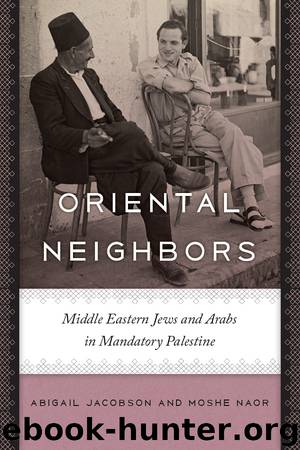Oriental Neighbors by Abigail Jacobson

Author:Abigail Jacobson
Language: eng
Format: epub, pdf
Publisher: Brandeis University Press
Indeed, as Norma Musih argues, Aharonson’s tone is condescending toward both the Jewish and the Arab inhabitants of Manshiyya. She considers them to be inferior to the rest of Tel Aviv’s Jewish residents, views them as a weak social group and a burden on Tel Aviv, and completely ignores the existence of some upper-class Arabs of the neighborhood.69 This notion of clear socioeconomic and ethnic divisions between Jews who lived in the frontier neighborhoods and those who lived in Tel Aviv, as well as the mention of prostitutes, will be discussed below.
Aharonson’s description was not unique; it was part of a discourse that took place in the Yishuv especially during periods of security tensions, when thousands of Jews left the frontier neighborhoods in the mixed cities and became refugees. This phenomenon revealed social, religious, and class tensions and created points of conflict and friction between populations that had limited contacts with each other during periods of peace and quiet. The Jewish leaders in Tel Aviv, for example, described the encounter with the residents of the frontier neighborhoods as one with the unfamiliar world of the Oriental ghetto. This encounter was colored by ethnic distinctions and images, since the residents of the border neighborhoods were identified mainly as Oriental Jews. In June 1936, for example, an activist in the labor movement described her encounter with Oriental refugees in the following terms: “Now we understood just how great the differences are within the communities that everyone refers to as ‘the Oriental communities.’ They include groups of cultured Jews who are devoted to the people and the land, as well as groups that are closer to our neighbors—and not to the best among them—than to ourselves.”70 Similar descriptions were used during the 1948 war by members of the departments of the Tel Aviv municipality responsible for taking care of the thousands of Jewish refugees who sought asylum in the center of the city.71 The situation in Haifa, where most of the Jewish refugees from the frontier neighborhoods were Oriental Jews, was similar.72
Neve Shalom, Kerem Hatemanim, and Karton are interesting cases of frontier neighborhoods, with a status of double marginality due to their municipal status vis-à-vis Tel Aviv and Jaffa and to the composition of their populations, with their large proportions of Yemenites (in the case of Kerem Hatemanim) or people from other Middle Eastern countries. As mentioned above, parts of these neighborhoods were in Jaffa, and residents paid their taxes to that city even though they received many services from Tel Aviv. With the escalation of national tension, and especially after the beginning of the Arab Revolt, they appealed to the Tel Aviv municipality, asking it to annex their neighborhoods. The reasons for annexation were the growing feelings of insecurity and the ongoing neglect of the neighborhoods by the Jaffa municipality, despite the taxes that were paid to it. However, the residents were constantly reminded by Tel Aviv municipality that they were in an inferior socioeconomic position, and their requests for annexation were not granted.
Download
This site does not store any files on its server. We only index and link to content provided by other sites. Please contact the content providers to delete copyright contents if any and email us, we'll remove relevant links or contents immediately.
| Africa | Americas |
| Arctic & Antarctica | Asia |
| Australia & Oceania | Europe |
| Middle East | Russia |
| United States | World |
| Ancient Civilizations | Military |
| Historical Study & Educational Resources |
Underground: A Human History of the Worlds Beneath Our Feet by Will Hunt(12024)
Sapiens by Yuval Noah Harari(5294)
Navigation and Map Reading by K Andrew(5111)
The Sympathizer by Viet Thanh Nguyen(4305)
Barron's AP Biology by Goldberg M.S. Deborah T(4099)
5 Steps to a 5 AP U.S. History, 2010-2011 Edition (5 Steps to a 5 on the Advanced Placement Examinations Series) by Armstrong Stephen(3689)
Three Women by Lisa Taddeo(3354)
Water by Ian Miller(3128)
The Comedians: Drunks, Thieves, Scoundrels, and the History of American Comedy by Nesteroff Kliph(3039)
Drugs Unlimited by Mike Power(2545)
A Short History of Drunkenness by Forsyth Mark(2233)
DarkMarket by Misha Glenny(2159)
The House of Government by Slezkine Yuri(2159)
And the Band Played On by Randy Shilts(2129)
The Library Book by Susan Orlean(2042)
Revived (Cat Patrick) by Cat Patrick(1963)
The Woman Who Smashed Codes by Jason Fagone(1929)
Birth by Tina Cassidy(1864)
The Absolutely True Diary of a Part-Time Indian by Sherman Alexie(1859)
